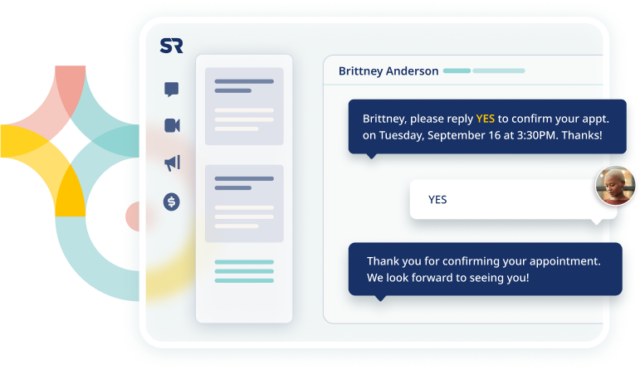10 Patient Satisfaction Survey Questions and Examples
Patient satisfaction is the cornerstone of a successful healthcare practice. Engaged, happy patients are more likely to return, recommend your services, and follow through on their treatment plans. But how do you know if your patients are satisfied?
Conducting a patient satisfaction survey and asking the right questions can help you uncover gaps in your patient experience and make informed improvements. Here are 10 examples of effective patient satisfaction survey questions to ask — along with ways to act on the insights using Solutionreach’s patient communication platform.
Examples of Effective Patient Satisfaction Survey Questions
1. How easy was it to schedule your appointment?
A smooth scheduling experience is one of the first interactions a patient has with your practice. If patients find the process frustrating, they may delay care or switch providers. We recommend making this question a survey rating scale from 1–10 to make the data easier to analyze.
Use this feedback to: Identify whether you need to simplify online scheduling, reduce hold times, or improve staff training.
Solutionreach Tip: Implement Online Scheduling to offer patients a seamless way to book appointments 24/7.
2. How long did you wait before seeing a provider?
Long wait times are a top complaint in healthcare. When patients wait too long, it negatively impacts their experience and increases the likelihood of missed appointments. A multiple-choice question with options in 15-minute increments works best for assessing wait times.
Use this feedback to: Adjust scheduling workflows, streamline check-in processes, and optimize appointment lengths to reduce bottlenecks.
Solutionreach Tip: Use Appointment Reminders to minimize late arrivals and keep your schedule running efficiently.

3. Did you feel listened to and understood by your provider?
Patients want to feel heard, respected, and understood. If they feel rushed or dismissed, satisfaction plummets, and they may seek care elsewhere. In fact, the Patient-Provider Relationship Study found that quality time with a provider is the top priority for many patients. This can be a simple Yes/No question with an option to provide more detail if they select “No.”
Use this feedback to: Provide training on active listening and patient-centered communication to improve provider interactions.
Patient Messaging to follow up with patients and ensure their concerns are addressed.
Solutionreach Tip: Use Patient Messaging to follow up with patients and ensure their concerns are addressed.
4. How would you rate the friendliness and professionalism of our staff?
Your front desk team sets the tone for the patient experience. A warm, welcoming environment makes a big difference in satisfaction and retention. Ask patients to rate their interactions on a scale of 1–10 and consider including an open-ended follow-up option. Patients may want to tell you about specific staff members who were helpful or share details of a difficult encounter.
Use this feedback to: Identify training needs, recognize outstanding staff members, and address any recurring issues.
Solutionreach Tip: Send Post-Visit Surveys to track and improve front-desk interactions.
5. Was your treatment plan clearly explained?
Patients who understand their diagnosis and treatment plan are more likely to follow through with care recommendations. This can be framed as a Yes/No question, with an option to call your practice or send a follow-up text if anything is unclear.
Use this feedback to: Improve practice communication, offer written or digital summaries, and provide follow-up education.
Solutionreach Tip: Help keep patients informed by using Patient Education to send personalized educational materials before and after a visit.
6. How satisfied are you with the follow-up care and communication?
Questions don’t stop when patients walk out the door. If they struggle to get answers, it can impact their health and satisfaction. Use a survey rating scale from 1–10 and give patients the option to explain their selection.
Use this feedback to: Improve responsiveness via phone, email, or patient portals and consider offering live chat support.
Solutionreach Tip: Enable Two-Way Texting to answer patient questions quickly and conveniently.
7. Would you recommend our practice to friends and family?
This is the ultimate measure of patient satisfaction. Use a survey rating scale to collect this feedback. A high grade means you’re doing things right, while a low score signals areas for improvement. If someone indicates that they’re willing, you may want to use this opportunity to ask them to refer a friend.
Use this feedback to: Identify strengths and weaknesses, improve areas with low ratings, and encourage satisfied patients to leave online reviews.
Solutionreach Tip: Use s Reputation Management to collect more online reviews and showcase positive patient feedback.
8. How satisfied were you with the comfort and cleanliness of our office?
A clean, comfortable environment helps patients feel at ease. An unkempt office can make them question your attention to detail in their care. A survey rating scale or multiple-choice question is ideal for collecting this feedback — just ask for feedback if they give you a low score.
Use this feedback to: Upgrade waiting areas, ensure regular cleaning, and create a welcoming atmosphere.
Solutionreach Tip: Track perception changes over time using Patient Surveys.
9. Did we provide enough information about your billing and insurance options?
Confusing bills and insurance policies frustrate patients and lead to dissatisfaction. Clear communication reduces financial stress. Use this Yes/No question to assess your communication concerning billing and insurance as opposed to the actual cost of services.
Use this feedback to: Simplify billing explanations, provide upfront cost estimates , and ensure staff can answer insurance questions.
Solutionreach Tip: Use Automated Payment Reminders to keep patients informed about payments and insurance details.
10. What is one thing we could do better?
This open-ended question provides valuable insights into patient expectations and experience gaps. We recommend having no more than one open-ended question in the entire survey, unless a patient has a negative experience and wants to provide more details.
Use this feedback to: Identify patterns, implement patient-driven improvements, and demonstrate responsiveness to concerns.
Solutionreach Tip: Use Patient Feedback to regularly gather and act on patient input.
Why Patient Satisfaction Matters
Patient satisfaction drives practice growth, retention, and reputation. High satisfaction scores correlate with better care adherence, stronger loyalty, and increased referrals. A patient satisfaction survey helps uncover what’s working and where your practice can improve.
Improve Patient Satisfaction with Solutionreach
The best way to enhance patient satisfaction is to listen to patients, adapt, and proactively improve. With Solutionreach’s all-in-one patient communication platform, you can automate surveys, streamline scheduling, improve communication, and create a better patient experience.





